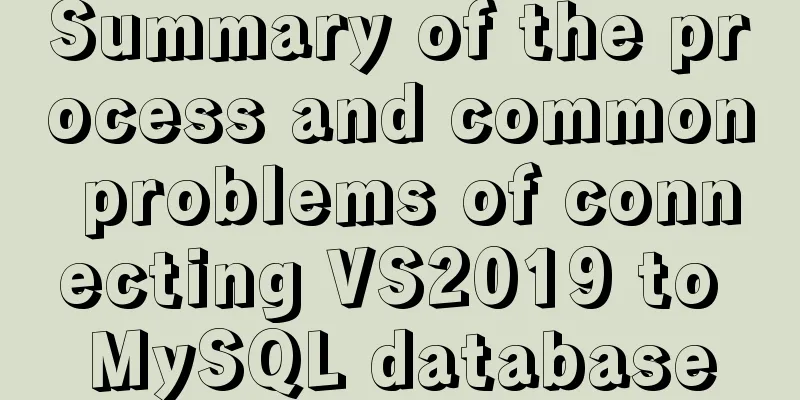Example of how to quickly build a LEMP environment with Docker

|
LEMP (Linux + Nginx + MySQL + PHP) is basically a must-have environment for web developers today. Under normal circumstances, we can directly install and use it through system package management tools such as apt and yum. However, due to compatibility considerations, the software sources that come with the system are often updated slowly and will stagnate at the previous version in about half a year, affecting developers' follow-up testing of new features. In order to pursue the latest version, many developers began to download source code packages and compile them themselves, but the process was too cumbersome, and later one-click installation packages such as Oneinstack and lamp.sh were created. The launch of Docker can greatly simplify the above process. There are many maintainers on Docker Hub who package various components such as PHP and nginx into images. As a user, you can build a LEMP stack by simply pulling the relevant images. And the features based on Docker bring at least the following advantages:
Two months ago, I started to build the entire LEMP framework and maintained some images myself as needed. The relevant orchestration templates are open source at https://github.com/metowolf/docker-lemp. Currently, the entire blog and API site are running on docker, and the operation is quite stable. container
Demo Let me demonstrate this with a simple example. First, you need to install the docker and docker-compose environments. For the convenience of demonstration, we will directly use the PWD trial host to run it. $ curl -fsSL https://get.docker.com -o get-docker.sh $ sh get-docker.sh $ curl -L "https://github.com/docker/compose/releases/download/1.23.2/docker-compose-$(uname -s)-$(uname -m)" -o /usr/local/bin/docker-compose $ chmod +x /usr/local/bin/docker-compose Log in to the server and pull the orchestration template $ git clone https://github.com/metowolf/docker-lemp.git $ cd docker-lemp Create a configuration file $ cp .env.example .env $ cp docker-compose.example.yml docker-compose.yml Create nginx configuration
$ cat > etc/nginx/config/example.conf <<EOF
server {
listen 80;
server_name example.com *.direct.labs.play-with-docker.com;
root /var/www/example.com;
index index.php;
location / {
try_files \$uri \$uri/ /index.php?\$query_string;
}
location ~ \.php\$ {
fastcgi_split_path_info ^(.+\.php)(/.+)\$;
fastcgi_pass php-fpm:9000;
fastcgi_index index.php;
include fastcgi_params;
fastcgi_param SCRIPT_FILENAME \$document_root\$fastcgi_script_name;
fastcgi_param PATH_INFO \$fastcgi_path_info;
}
}
EOFCreate phpinfo file $ mkdir wwwroot/example.com/ $ cat > wwwroot/example.com/index.php <<EOF <?php phpinfo(); EOF Start the container $ docker-compose up -d php-fpm nginx mysql After the startup is successful, if there are no accidents, we can see the familiar page on port 80.
Advanced gameplay QUIC In the orchestration example, I added a caddy to reverse nginx to get the quic feature. With the help of docker's features, we can let caddy listen to port 443 udp alone, and let nginx still listen to port 443 tcp, so that TLSv1.3 and quic can be taken into account at the same time. A return header needs to be added in the nginx configuration to remind the browser to try to connect to quic add_header alt-svc 'quic=":443"; ma=2592000; v="44,43,39"'; brotli In the nginx container, I compiled brotli into a dynamic module that can be enabled as needed. Create a new etc/nginx/nginx.conf configuration file
user nginx;
worker_processes auto;
error_log /var/log/nginx/error.log warn;
pid /var/run/nginx.pid;
# Mount the brotli module load_module modules/ngx_http_brotli_filter_module.so;
load_module modules/ngx_http_brotli_static_module.so;
events {
worker_connections 1024;
}
http {
include /etc/nginx/mime.types;
default_type application/octet-stream;
log_format main '$remote_addr - $remote_user [$time_local] "$request" '
'$status $body_bytes_sent "$http_referer" '
'"$http_user_agent" "$http_x_forwarded_for"';
access_log /var/log/nginx/access.log main;
sendfile on;
#tcp_nopush on;
keepalive_timeout 65;
#gzip on;
include /etc/nginx/conf.d/*.conf;
}Create a new etc/nginx/config/brotli.conf configuration file brotli on; brotli_comp_level 6; brotli_types application/x-httpd-php application/javascript application/x-javascript application/xml application/json text/plain text/javascript text/css text/xml image/jpeg image/gif image/png image/svg+xml; Modify docker-compose.yml to mount the nginx.conf configuration file ---docker-compose.yml +++ docker-compose.yml @@ -11,6 +11,7 @@ -php-fpm volumes: - ./log/nginx:/var/log/nginx:rw + - ./etc/nginx/nginx.conf:/etc/nginx/nginx.conf:rw - ./etc/nginx/config:/etc/nginx/conf.d:rw - ./etc/ssl:/etc/nginx/ssl:rw - ./wwwroot:/var/www:rw @@ -65,6 +66,8 @@ Finally, update the container orchestration $ docker-compose up -d --no-deps --build The above is the full content of this article. I hope it will be helpful for everyone’s study. I also hope that everyone will support 123WORDPRESS.COM. You may also be interested in:
|
<<: A detailed discussion of MySQL deadlock and logs
>>: Detailed explanation of MySQL batch SQL insert performance optimization
Recommend
mysql three tables connected to create a view
Three tables are connected. Field a of table A co...
Basic installation tutorial of mysql decompression package
Since I have changed to a new computer, all the e...
MySQL 5.7.20 compressed version download and installation simple tutorial
1. Download address: http://dev.mysql.com/downloa...
How to deal with too many Docker logs causing the disk to fill up
I have a server with multiple docker containers d...
MySQL index cardinality concept and usage examples
This article uses examples to explain the concept...
Docker advanced method of rapid expansion
1. Command method Run the nginx service in the cr...
Detailed explanation of the buffer pool in MySQL
Everyone knows that data in MySQL needs to be wri...
React+Amap obtains latitude and longitude in real time and locates the address
Table of contents 1. Initialize the map 2. Map Po...
Detailed explanation of MySQL backup process using Xtrabackup
Table of contents 01 Background 02 Introduction 0...
How to completely delete the MySQL service (clean the registry)
Preface When installing the executable file of a ...
mysql is not an internal command error solution
The error "mysql is not an internal command&...
Nginx one domain name to access multiple projects method example
Background Recently, I encountered such a problem...
Import csv file into mysql using navicat
This article shares the specific code for importi...
Linux implements automatic and scheduled backup of MySQL database every day
Overview Backup is the basis of disaster recovery...
Implementing countdown effect with javascript
Use Javascript to achieve the countdown effect, f...










